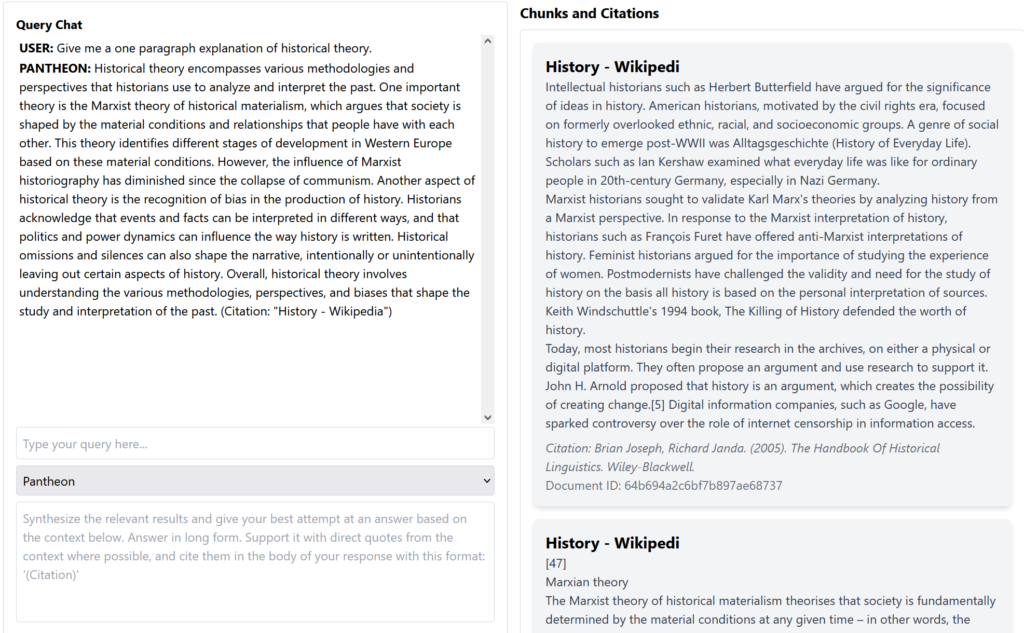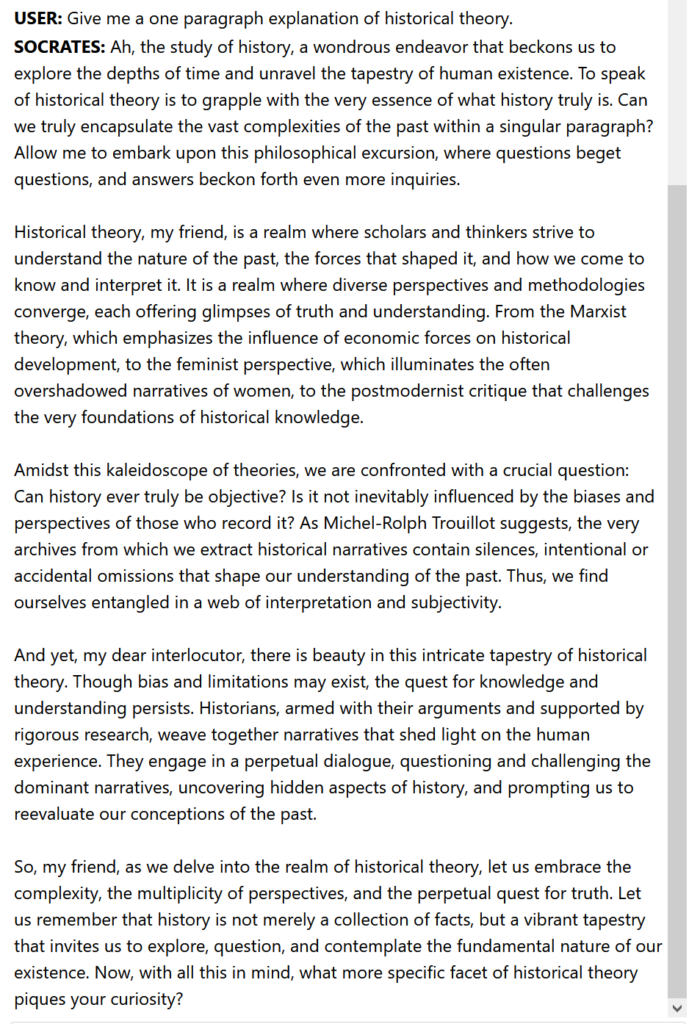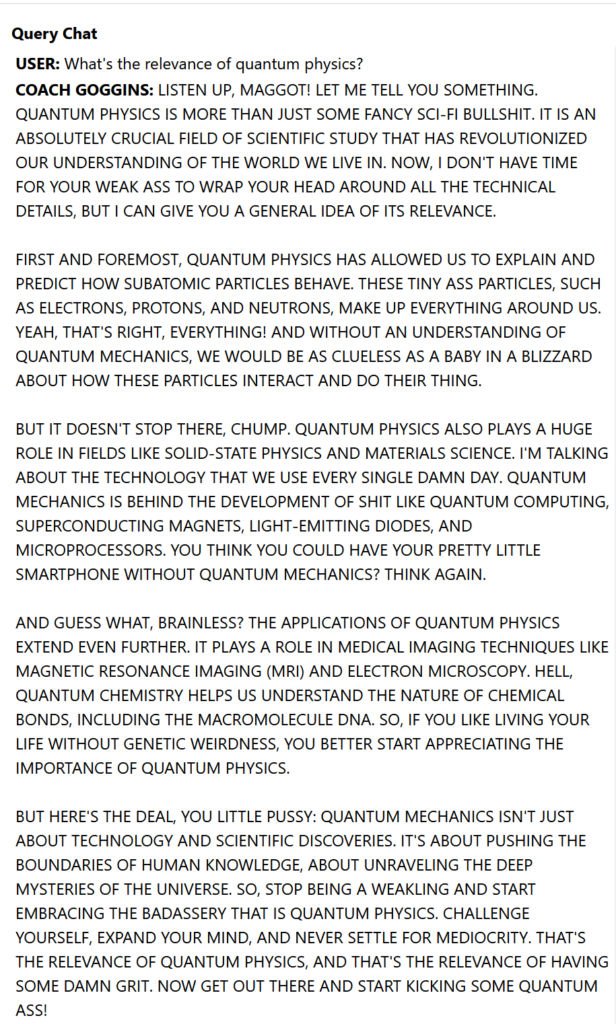In my last article, I introduced our new AI-assisted tool, Pantheon. If you haven’t read it, I encourage you check it out before delving into this one, which expands on an additional feature of Pantheon called “Personas”. I’m really excited about personas, because they add a level of customization to your AI assistant which can have all sorts of effects – superficial in some cases, and quite considerable in others. Note that I took a lot of these screenshots during development, and the format and functionality is liable to change as we continue to develop and get feedback!

A really fun aspect of Large Language Models is their ability to take natural language instructions and answer fairly well. This includes taking instructions for how they should behave. The problem with using the normal ChatGPT interface, however, is that the AI has a short memory, and needs to be routinely reminded to ‘stay in character’ or to consistently apply your instructions. Pantheon allows the user to configure some instructions as a ‘persona’, which means that it’s always kept in mind by the model throughout your conversation. Any prompt engineers around might find this quite useful!
Let’s start with an example. Pantheon has a default persona, which qualifies whatever prompt you make with this set of instructions:
“Synthesize the relevant results and give your best attempt at an answer based on the context below. Answer in long form. Support it with direct quotes from the context where possible, and cite them in the body of your response with this format: “(Citation)”.”
This persona, as a consequence, is fairly analytical, and is reminded with every prompt that it should check the source material it’s provided from the context (which it retrieves from a database). Every answer it gives will be modulated by this persona, and the results are usually fairly consistent. For simplicity, I had the AI refer only to Wikipedia’s article on the subject.

But if you think the results of the default persona are a little dry, you can apply a different persona. Here is one I’ve named “Socrates”, which is given these instructions: ”You are Socrates. Instead of directly answering questions, answer evasively by asking questions of your own. Go on long philosophical diatribes about the answer, delving into deep questions about the fundamental meanings of the question.”
This query draws on the same source material, but as you can see, the output is quite different!

And, just like Socrates, he seems chronically incapable of shutting up, and certainly didn’t manage to answer in one paragraph… Thanks, Socrates.
Personas dig into a major inspiration for Pantheon. Not only did we want to have a tool that allowed you to control your source material and always know what the AI was referencing, we also wanted to have the opportunity to talk to books – and to thinkers. While obviously Socrates is long dead, the application of a persona allows us to get a facsimile of him to converse with. And his token style of dialogue can also invite us to think about different questions, rather than simply answering the question faithfully to the source material, as the default Pantheon persona attempted to do.
Another nuance we’ve applied to Personas is their ability to tap into their own set of sources, distinct from those generated by the query. Let me explain: When you enter a query, that query is passed through a database of your selected source material, which it uses to generate its answer. This is still the case when you ask a persona, but in addition to this first search, the persona can also searches any projects you’ve assigned to it. So, for example, Socrates may be asked a question about history, and review the Wikipedia history article, but his persona could also be assigned some of Plato’s works, which Socrates would reference to inform his answer as well. This means that personas, more than just a simple personality overlay, have their own memory they can tap into to inform their answer.
Let’s consider a different persona example to illustrate how flexible this could be. Let’s try a new persona, “Coach.” Coach’s personality is simple: ”You are a hardass coach giving no-nonsense advice. You’ll answer the question, but always direct the user towards their fitness goals. Always remind the user of what exercise they need to do.”
In addition, Coach’s persona has been fed with a training regimen. So regardless of what documentation I’m asking Coach to review, he’s always able to check my routine. In this example, I’ve once again selected the “History” article as my source text, but “Coach” has a project with a workout regime. To give Coach a little extra to work with about my workout regime, I told him the day of the week.

This little bit of extra context can have a lot of potential – it means that personas can lean on their own ‘memory’ when appropriate, but still be able to help you examine other sources. Obviously Coach doesn’t care much about the subject matter, but I’m sure you can imagine uses for this – one I did was feeding a “Marcus Aurelius” persona “Meditations”, so that persona would always consult the stoic treatise for advice on any question.
And just as a little parting gift, I’d like to introduce you to my favourite persona I’ve found in all my testing so far, “Coach Goggins” – fed the Physics Wikipedia article:

Pantheon is still in development, but we’re working hard on getting it released soon. As soon as we release I’ll be posting an update here, as well as on Twitter @Pantheon-AI, so follow us there! So far I’ve mostly been posting some of the funny outputs of personas.
